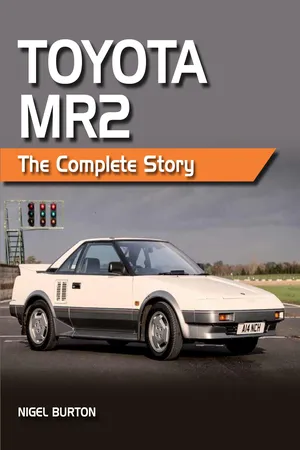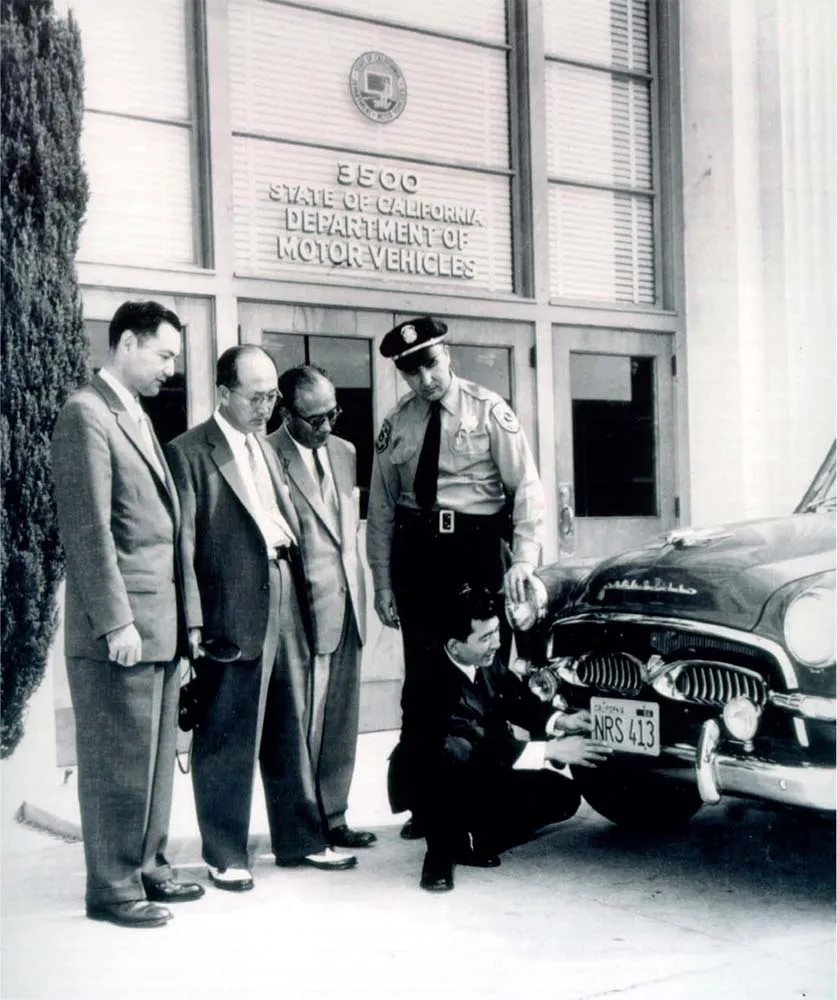![]()
CHAPTER ONE
‘VALUE UNATTAINED IN ANY OTHER AUTOMOBILE …’
The stevedores unpacking two small cars from the deck of the passenger liner President Cleveland at the Port of Long Beach, California, on 14 September 1957 almost certainly had no idea that they were making history. Nor did the modest crowd of journalists and civic dignitaries who gathered to watch the cars – one in Coronada Beige, the other resplendent in blue – as they were unloaded onto the dockside.
But for the Japanese officials present, the arrival of two Toyota Toyopet Crown sedans all the way from Yokohama harbour was a moment of immense importance: the first Japanese cars officially imported to the United States.
Earlier a group of thirty-five guests, including four Toyota executives, the Japanese consul general, the manager of the Bank of Tokyo, select pressmen and harbour officials, had gathered aboard the liner for a celebratory lunch. Afterwards they adjourned to the dockside for photos by the berth. No doubt, some of the photographers were more interested in Kyoko Otani, Japan’s entrant in that year’s Miss Universe beauty pageant, who hovered nervously clasping a bouquet of flowers while the cars were made ready.
History is made as the first Toyota – a Toyopet Crown – arrives in the United States. TOYOTA USA ARCHIVES
As the first vehicle was swung onto the dock, she glided forward and gently placed the bouquet on the bonnet: the first Toyota had officially touched down in the world’s biggest car market. (The guests were not to know, but the Crowns had been quietly unloaded in San Francisco a couple of days earlier to be washed and watered ahead of their formal unveiling.) The automobile industry would never be the same again.
The Toyopet Crown was designed and built by a new name in the international automobile world: Toyota of Japan. It was compact by American standards and the 1.5-litre 4-cylinder engine was comically small in a market where the best-selling car (the Ford Fairlane) came with either a 3.7-litre straight six or a 4.5-litre V8. However, Toyota was convinced that it would tap into the growing market for small cars. Instead of performance and speed, the Crown would sell on its value for money, four-door convenience and comfort.
To succeed, Toyota had to take on the Europeans. In the first five months of 1957 total imports exceeded $100 million. Volkswagen had a handsome lead with 40,139 cars, British importers came next on 34,141 and Renault was in third place with 11,587. Volvo accounted for 5,586 imports and Fiat just 1,127 vehicles.
The surge in small car sales encouraged Toyota executives to aim high. Seisi Kato, chairman of Toyota Motor Sales (TMS), remembered:
Exporting passenger cars to America, the ‘home’ of the passenger car; in those days it seemed like some wild dream come true.
During our test driving tour we introduced the Crown to various dealers, who all seemed impressed and spoke highly of the car’s market potential. From their responses our estimates were that 400 or 500 units could be sold a month; at that rate, we extrapolated that we could easily move a total of 10,000 units a year, and would just have to insist that Toyota Motor Company raise its production capacity to meet what we saw as clamorous demand.1
Toyota hoped to sell 500 Crowns a month in the US, but expectations were hopelessly optimistic. TOYOTA USA ARCHIVES
But the newsmen who watched the first cars arrive were sceptical. It had taken Volkswagen several years to achieve that kind of figure and the delicate-looking Toyopet Crown, despite its US-inspired styling, did not have the Beetle’s unique sales appeal.
Writing in the Indiana Gazette many years later, reporter Jim Bishop remembered his first meeting with a Toyopet: ‘My brother John … paid cash and drove it off an import dock. We crowded around it at the curb. [Our father] came out in his carpet slippers. His white head shook from side to side. “Did an engine come with that thing,” he said. “Or was it towed here?” ’2 His acerbic comment would prove to be uncannily accurate.
When the pressmen had got their stories and photos the Toyopets were checked by the customs examiner on the docks before being filled up and driven back to Los Angeles by Shotaro Kamiya, president of Toyota Motor Sales (TMS), and Shoji (George) Hattori, the head of TMS’s export division.
The following Monday the cars were driven to the Motor Vehicle Department where they were officially registered. A photographer from the Kyodo News Agency was on hand to record the moment for posterity and the pictures were sent back to Japan.
The happy photos, however, disguised major problems behind the scenes. A 927-mile test drive from San Francisco to Richmond, California, showed the little Toyopets to be out of their depth on America’s wide and smooth roads. Hattori sent an urgent message back to Japan:
Mr Kamiya and myself drove two Toyopets to Richmond, near Oakland, on October 15 and returned to Los Angeles on October 17. Mr Kamiya drove the RSL (beige color) and I drove the RSDL (blue color) [Crown Deluxe]. The California highway speed is 55mph (85km/h) at the present time, but there is now talk of lifting this maximum speed to 65mph (105km/h).
We did not have any trouble for the entire trip (not even a flat tire), but the RSL which was repaired prior to the trip (new camshaft etc) started to make the same noise again in the engine (just like a diesel) after 100 miles, but since we could not very well turn back, we continued with the journey.
There must be something wrong with the vehicle; therefore, now that the journey has ended, we are storing it until our Toyota service men come to the US in the future, since we cannot risk having it repaired over and over again for fear of ruining our reputation.
Toyota was so proud of its achievement in exporting cars to the USA that it marked every stage of their arrival. Here the first Crown receives its licence plates. TOYOTA USA ARCHIVES
In a follow-up letter, sent on 21 December 1957, Hattori said the exact cause of the engine malady could not be found and it would be shipped back to Japan for a full strip down.
The problem turned out to be the engine’s crankshaft, which had three main bearings when it really needed five. This design was fine in Japan, where the poor road system made high-speed driving impossible, but in the USA sustained cruising stressed the components to breaking point. At anything over 50mph (50km/h) the engine vibrated so badly the whole cabin shook. Pushed further, it broke. As Seisi Kato explained:
When the Crown was tried out on US freeways at 80mph, loud noises soon erupted and power dropped sharply. More trouble occurred before we had logged even 2,000 miles.
Although many people had praised the Crown as a ‘baby Cadillac’, for example, our engines, designed for the narrow-road, low-speed driving of Japan in those days, could not even begin to handle the performance and endurance demands placed upon them.3
One of the ill-fated Crowns makes its way through the Yosemite National Park. Wide-open freeways and steep hills would prove too much for the Toyopet’s small engine. TOYOTA USA ARCHIVES
Despite reservations among Toyota officials in the USA, Japan insisted on pressing ahead with sales and an office was duly opened in ...





